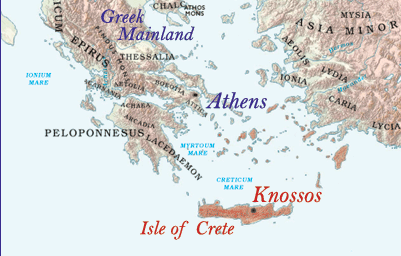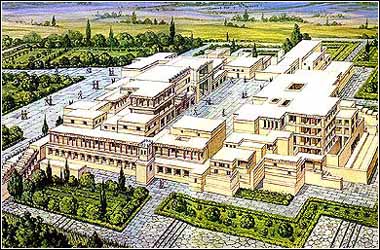 |
-History/Myth-
|
|
|
|||
|
| |||
|
|
|||
A Fascinating Journey...History behind the Legends
A projection of history depicting the fall of the Cretan Empire and the rise of Greek democracy in 1400 BC - involving a revolt led by groups of athletes in an ancient spectator sport, the Cretan 'circus of the bulls,' known as the "Bulldance."
| Behind the Legend of Atlantis... |  |
|
Archeology shows the Island-Empire of Crete in the Mediterranean -- which at one time threatened to conquer most of Southern Europe. |
|
| Behind the Legend of the 'Minotaur'... | |
| While there was no "monster" devouring youths and maidens in ancient times -- there is evidence of a "monstrous" gladiator sport in the Island-Nation of Crete - the Bulldance - which in effect would have "devoured" young athletes -boys and girls- sent as tax payments from smaller countries at the time. | |
 |
 |
|
Restored, historical painting from the ancient city of Knossos, Crete |
Projection of Admin. Complex, Ancient Knossos, Crete |
...these "indentured athletes"-
led by a group from Athens - would
have faced a choice between their own survival and the birth of a new way
of life -- the first middle-class movement
-- and the first democracy in the ancient
world, in 1400 BC.
|
TRACING
THE AMERICAN VISION
Behind the Story
Most historians agree on the key elements of the American system -- the idea of the social contract, distribution of power among classes (voting), and individual fairness (equity) – all of which can be traced back.....
And
the most "American” element goes back even further,
to ancient Indo-European philosophy
– |
||||
|
STORY
SETTING
An Ancient Middle Class? |
|
Where
is the first evidence of a 'class movement' in ancient history?
The beginning of this middle-class movement can be traced back years before to a philosopher-prince called Theseus -- of Indo-European ancestry -- and a group of comrades from Athens, thought to be organizing the first craft guilds and free-markets for peasant farmers in the Attica region of Greece -- hoping to expand this to all the kingdoms of the Greek Mainland -- against the wishes of the ruling class.
However,
the young group not only survives --
but by making alliances with the athletes already there, and craftsman-trade
factions within the Cretan government -- they are able
to upset the Cretan plans for
conquest, and return to Greece to start a democratic
tradition at Athens.
Later, beyond our story
-- the ruling Myceneans were in fact driven out of power on the Greek
Mainland. And though the country reverted to a "dark age"
of regional conflict and strife soon after -- some elements of the democratic
form survived in Athens until its full rejuvenation in the Classical,
or Golden Age.....800 years later.
|
||||||||||
| Introduction | • |
Story | • | Scenes | • |
Music | • |
Themes | • |
Characters | • |
Research | • | Associates | • | Mission | • |
Contact | • | Site Map |